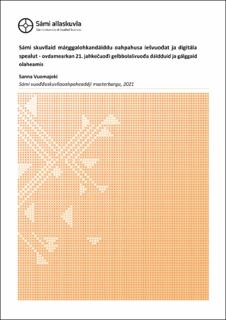Sámi skuvllaid máŋggalohkandáiddu oahpahusa iešvuođat ja digitála spealut - ovdamearkan 21. jahkečuođi gelbbolašvuođa dáidduid ja gálggaid olaheamis
Master thesis
Published version
Permanent lenke
https://hdl.handle.net/11250/3014296Utgivelsesdato
2022Metadata
Vis full innførselSamlinger
Sammendrag
Masterdutkamuša lean guorahallan makkár iešvuođat leat Sámi skuvllaid máŋggalohkandáiddu oahpahusain, geavahit go digitála spealuid dákkár oahpahusain ja makkár ovdamuniid oahpaheaddjit oidnet dáid geavaheamis. Dáid iešvuođaid vuođul fuomášuhtán movt Sámi skuvllat orrot nagodeami bargat boahtte áiggi skuvlla jurdaga guvlui, 21. jahkečuođi gelbbolašvuođa, dáidduid ja gálggaid olaheamis. Barggu teorehtalaš vuolggasadjin leat máŋggalohkandáidu, dihtorspealut, 21. jahkečuođi gelbbolašvuohta (21st century skills) ja dáidda gullevaš pedagogalaš rámmat. Dutkamuš lea dahkkon sámi skuvllain, ja dutkamuššii leat oassálastán oktiibuot 15 sámegielat oahpaheaddji Norggas ja Suomas. Dutkamuš lea kvalitatiiva dutkan ja dutkanmateriála lea čohkkejuvvon elektrovnnalaš jearahallanskoviin ja jearahallamiiguin. Sámi skuvllaid máŋggalohkandáiddu-doahpagii lasihit dovdomearkkaid sámi ipmárdusvuođus ja sámi kultuvrras, mas deattuhit sámi identitehta, sámi jurddašeami nannema, árbevirolaš máhtu, bargovugiid mat adnojuvvojit vuođđoealáhusain ja vel praktihkalaš bargguid bokte oahppama. Máŋggalohkandáiddu oahpahusa bargo- ja oahpahusvugiin oktan digitála spealuid pedagogalaš geavaheamis leat elemeanttat sámi árbevirolaš bajásgeassimis nugo geahččaladdan ja oahppan, oahppi beassá meaddit, ođđasit geahččalit ja de loahpas lihkostuvvat. Eanas sámegielat oahpaheaddjit geavahit digitála reaidduid oahpahusas iešguđetge fágain, muhto dávjjimusat sámegiela fágas. Digitála spealut ovddidit sámi ohppiid birgendáidduid mat leat dehálaččat sin boahtteáiggis. Dát maiddái ovddidit sihke kognitiiva-, sosiála- ja emošunealla dáidduid, nugo gulahallan- ja jođihandáidduid, hálddašit dovdduid, iešbirgejumi, ovddidit identitehta, vásihit sihke lihkostuvvama ja eahpelihkostuvvama. Go buohtastahtán 21. jahkečuođi gelbbolašvuođa jurddašeami sisdoalu ja sámegielat oahpaheddjiid máŋggalohkandáiddu oahpahusa sisdoalu, de leat dáin ollu oktasaš áššit. Dát leat dákkár dáiddut maid dán áigge mánát ja nuorat bohtet dárbbašit bajásšattadettiin boahtteáiggi servodaga miellahttun digitála máilmmis. Nie čájeha dát ahte sii leat juo bargame 21. jahkečuođi gelbbolašvuođa mihttomeriid ollašuhttima guvlui. In my master's thesis, I have investigated characteristics of how Sami schools are teaching multiliteracy, do they use digital games in such teaching and what are the benefits of this use. By using these characteristics, I have drawn attention to how Sámi schools are preparing pupils towards the understanding of 21st century skills. The theoretical approach of the work is multiliteracy, computer games, and 21st century skills include related pedagogical frameworks. The research has been done at Sámi schools, with 15 Sámi-speaking teachers participating in Norway and Finland. This study is qualitative research using electronic surveys and interviews for data collecting. Results show that in defining multiliteracy the Sámi schools expand the concept by using characteristics from Sámi understanding and Sámi culture, by emphasizing Sámi identity, strengthening of Sámi understanding, traditional knowledge, working methods used in primary industry and even learning through practical work. The teaching methods of multiliteracy, including using digital games have elements from Sámi traditional form of raising, e.g. such as trial and error, the student has the opportunity to make a mistake, do it again and then finally succeed. Most Sámi-speaking teachers use digital tools in teaching different subjects. Digital games develop Sámi students’ skills to manage that are important in their future. These also develop both cognitive, social, and emotional skills, such as skills in communication and management, skills for managing emotions, integrity, developing identity, and experiencing both success and failure. By comparing the understanding of 21st century skills with the Sámi speaking teachers' understanding of teaching multiliteracy, there are a lot of common issues. These are skills that children and young people need while growing up in the society of the future and as a member of the digital world. Thus, this shows that Sámi teachers are already working towards the 21st century completion of the competence objectives.
